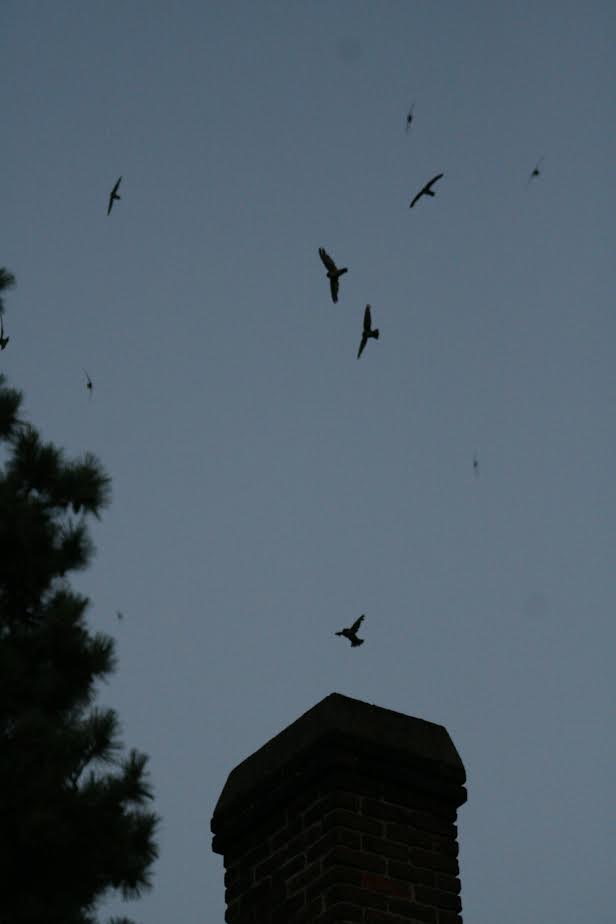Project Description
Since 2011, volunteers have gathered to count migrating Vaux’s Swifts (Chaetura vauxi) roosting in chimney sites in Bend. They begin counting early to mid-April (northward migration) and again in early to mid-August (southward migration). They start watching the chimneys used in prior migrations and count for about 1.5 hours/night. Counts begin at zero and count nightly as swift numbers peak and then drop off to zero again. Fall counts yield greater nightly roosting numbers as juvenile swifts, born a few months earlier, are making their first southern migration. The 2022 fall count began with zero birds in early August peaking at 4,700 a month later, then back to zero in late September.
Historically, Vaux’s Swifts roosted in old growth snags. When many years of logging limited the availability of snags, swifts adapted to using chimneys for their roosting needs. Old chimneys made of bricks and oozing mortar give the non-perching swifts a place to hang by their claws.
Why We Do This and What We Have Learned
In 2008, the National Audubon Society launched an online survey tool for Vaux’s Swift counters along their Pacific flyway migration route, to bring cohesion to the sporadic counts made prior to that time. By 2021, volunteers were counting at 40 sites. This is research early in the making. Researchers rely almost exclusively on volunteers for data, and have recently been experimenting with geotagging and other information-gathering techniques. To learn more about Vaux’s Swift citizen research and examine the data, go to www.vauxhappening.org.
What Volunteers Do
Volunteers meet at roosting sites around the west an hour or so before sunset. In Bend, that is the parking lot of the Boys and Girls Club downtown. The club generously left standing a no-longer used chimney to serve the exhausted migrating swifts. Volunteers meet to receive pointers on what to watch for and how to count a squadron of swifts diving down a chimney. The count continues until no more swifts are aloft and all have headed down the chimney or even moved on.
Volunteers and community members are also encouraged to keep an eye out and report Vaux’s Swifts that may be using other Bend chimneys.
Project Focus Areas
- Bird Conservation
- Endangered/Threatened Species
- Ecological Study
- Behavioral Study
- Activism/Advocacy
- Climate Change Impacts
- Population Monitoring
- Community Engagement
Would You Like to Volunteer?
Does the idea of watching up to 4,800 (or even 3 or 4) tiny speed demons converging above a chimney into a frenzied tornado and diving in for a night of clinging to the mortar or to each other for a good night’s rest sound exciting? It is.
If migration is underway, on warm evenings, head to the Boys and Girls Club in downtown Bend a half-hour or so before sunset. In colder weather, they may roost an hour or two earlier. Should more chimneys be found in the area with roosting swifts, volunteers will be needed to assume responsibility for counting and submitting the survey tool.
The Vaux Swift Research Project is being coordinated by the National Audubon Society and Larry Schwitters is the national administrator. Information about the survey data, Vaux’s Swifts, and contact information for Larry Schwitters, can be found at: www.vauxhappening.org. Another good source of information about these fascinating birds can be found on eBird Northwest.
If you’d like to get involved with this project locally or if you have further questions, email ECBA at ecba@ecbirds.org. Please put “Vaux’s Swift Migration Survey” in the subject line.
Project Reports and Information
Other Projects
- Bluebird Nest Box Project
- Cabin Lake Bird Blind
- Deschutes Land Trust / ECBA Bird Surveys
- Don and Lowell Franks Nest Box Project
- Geographic Information Systems (GIS) Project Support
- Golden Eagle Nest Camera on Whychus Creek
- Greater Sage-Grouse Project
- Hummingbird Garden at Bend’s Orchard Park
- Kestrel Nest Box Project
- Lake Abert Coalition Bird Survey
- Pinyon Jay Study
- Summer Lake Shorebird Survey
- Winter Raptor Surveys


